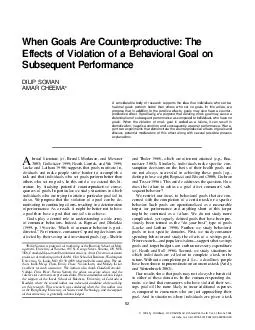/


Vol 31 June 2004 All rights reserved 009353012004310100051000 When Goals Are Counterproductive The Effects of Violation of a Behavioral Goal on Subsequent Performance DILIP SOMAN AMAR CHEEMA A considerable body of research supports the idea that ind ID: 44087
Download Pdf The PPT/PDF document "by JOURNAL OF CONSUMER RESEARCH Inc" is the property of its rightful owner. Permission is granted to download and print the materials on this web site for personal, non-commercial use only, and to display it on your personal computer provided you do not modify the materials and that you retain all copyright notices contained in the materials. By downloading content from our website, you accept the terms of this agreement.
andThaler1988),whichareoftennotattained(e.g.,Bau-meister2002).Similarly,individualsmakespeci ccon-sumptiondecisionsonthebasisoftheirhealthgoalsandarenotalwayssuccessfulinachievingthesegoals(e.g.,dietingtoloseweight;BagozziandEdwards2000;CochranandTesser1996).Thisarticleaddressesthequestion,Howdoesthefailuretoachieveagoalaffectconsumerssub-sequentbehavior?Werestrictourfocustobehavioralgoalsthatarecon-cernedwiththecompletionofacertaintaskoraspeci c JOURNALOFCONSUMERRESEARCHoutcome.Consideranindividualwhowantstosavemoney.Onegoalthispersonmightsetistosave$500eachmonth.Thisunambiguousspeci cationofareferencepointsetsatargetthatmustbemetfortheefforttobeconsideredasuccess,andanythingshortofthistargetwouldbecodedasafailure.Werefertosuchgoalsasall-or-nothinggoals.Incontrast,theindividualmayspecifythattheirgoalistoimprovetheirmonthlysavingsrateovertime.Inthiscase,thereisnoprespeci edtarget,andthenumberofdollarsputasideeachmonthcanmeasuresuccess.Inthiscase,successisnotabinaryattain/violatedistinction,butismoregraded.Werefertosuchgoalsasgradedgoals.Thisperspectiveisconsistentwithpriorresearch(cf.CochranandTesser1996;Heathetal.1999)thatdistin-guishesbetweengoalsfortheeliminationofanundesirablebehavior(e.g.,quittingsmoking)thataretypicallyofanall-or-nothingnature,andgoalsforattainingdesirablebehaviors(e.g.,learning)thataretypicallygraded.Wefocusonall-or-nothinggoalsandinvestigatewhyfailuretoattainthesegoalsresultsinpoorersubsequentperformance.First,weconsiderresearchinsocialpsychology,whichshowsthatactivitiescodedasfailures(ratherthanpartialsuccesses)arelikelytoresultinlowerperceivedself-ef -cacy,whichinturnhasbeenshowntoresultindemotivation,lowergoalcommitmentandconsequentlylowerperfor-mance(BanduraandSimon1977).Theeasieritistocodeanoutcomeasafailure(givenall-or-nothinggoals),themorelikelyitisthatanindividualwillbedemotivatedtocontinuestriving,andhencetheirsubsequentperformancemaysuffer.Asecondstreamofresearchofferingasimilarconclusionisthatintheareaofself-monitoring.Researchershaveshownthatinassessingtheeffectivenessofgoals,individ-ualscompareestablishedstandardsofperformance(i.e.,thegoal)withfeedbackaboutactualperformancetypicallyob-tainedthroughself-monitoringproceduresinwhichtheyobserveandevaluatetheirbehavior(LockeandLatham1990).Inthecaseofall-or-nothinggoals,thisself-moni-toringwillresultinthetrackingofbehaviorsthatarein-consistentwiththegoal,whichhasbeenshowntobedet-rimentaltoperformance(Bandura1986).Forinstance,researchhasshownthattrackingofgoal-inconsistentbe-havioractuallyincreasedtheincidenceofsmokinginin-dividualswhowereattemptingtodecreaseit(seeCochranandTesser1996).However,inthecaseofgradedgoals,theeffectofself-monitoringwillbepositiveandhenceisnotlikelytoresultinadeteriorationofperformance.Third,theviolationofanall-or-nothinggoalresultsinthegenerationofstrongnegativeemotions(Heathetal.1999).Priorresearchsuggeststhatindividualswhoexpe-riencenegativeemotionsengageinemotionalrepairthroughdistractionandbydivertingattentiontoactivitiesthatcangeneratepositiveemotion(cf.Connolly,Ordonez,andCoughlan1997;GarbarinoandEdell1997).Individualswhoviolateagoalinoneparticulardomainmaythereforebemotivatedtoshiftresourcestoanalternatetaskorgoal,All-or-nothinggoalsmaybeconsideredmorespeci cthangradedgoals,holdingpeopletoastricterstandard. hurtingperformanceontheoriginaltask.Intherealworldwhereconsumershavemultiplegoals,violationofonegoalmaycausethemtoshiftattentiontoother,moreachievableAfourthstreamofresearchfocusesontheso-calledre-boundeffect.Ithasbeenshowninvariousdomains(e.g.,thoughtsinadults,obedienceinchildren)thatafteraperiodofarti cialsuppressionofathoughtorbehavior(asmightbeexpectedingoalstoeliminateundesirablebehaviors),thesuppressedthoughtoractivityisengagedinmorefrequentlythaniftherewerenoattempttosuppressit(Wegneretal.1987).Duringtheperiodofsuppressionindividualsresorttodistractersandimposepsychiccostsonthemselvestokeeptheunwantedactivityatbay.However,asthesepsychiccostsrequireeffort,individualsmightplantoimposethemonlyforalimitedperiodoftime.Oncethisperiodisover,thesepsychicconstraintsaresuddenlyreleasedandthisfacilitatestherecurrenceoftheforbiddenactivity(Wegneretal.1987).Theviolationofanall-or-nothinggoalmightsignalthecom-pletionofaperiodofsuppression,andtheensuingreboundwouldresultinpoorsubsequentperformance.Thus,fourindependentstreamsofresearchleadustohypothesizethatTheviolationofabehavioralgoalthatconstrainsanundesirableactivitywillresultinanultimatedeteriorationofperformance.Oncethegoalisvi-olated,thepreviouslyconstrainedactivitywillbeengagedinwithagreaterlikelihoodthanifthegoalwasyettobeviolated.Consistentwiththisprediction,CochranandTesser(1996)offertheexampleofastudentwhowasstrivingtoreduceweightusingadailycaloricgoal.Oneday,thestu-dentrealizedthatthedailyquotaofcalorieshadaccidentallybeenexceededandproceededtoconsumeapplepie.ThereasoningwasWhat-the-hell.SinceImalreadyovermygoal,itdoesntmatter.CochranandTesser(1996)refertothisresponseasawhatthehelleffect.RecentresearchbyDharandSimonson(1999)isalsoconsistentwithhypothesis1andthewhatthehelleffect.Theseauthorsshowthatwhenconsumerstradeoffagoal(likethepresenceorabsenceofpleasure)witharesource(likemoney),theypreferahighlightingstrategyinwhichallgoal-consistentconsumptionoccursinoneepisode.Forexample,inselectinganappetizerandentre´e,aconsumerwillselectatastyappetizerandatastyentre´eononedayandatastelessyethealthyappetizerandentre´eonanotherday.Ourframeworkwillmakeasimilarhighlightingpre-dictionforaconsumerwhosegoalistoavoideatingtastyandunhealthyfood.Ifthisconsumerhasalreadyviolatedagoalbyconsumingarichappetizer,ourframeworkpredictsthattheymightgoaheadandconsumethetastyentreanyway.Basedontheearlierdiscussion,weexpecthypothesis1toholdunderthefollowingconditions:1)Thegoalisanall-or-nothingtypeofgoal:Weexpectthedeteriorationofperformancetooccurforall-or- JOURNALOFCONSUMERRESEARCHTABLE1EFFECTOFTARGETDISCRETIONARYSPENDINGANDPREVIOUSDISCRETIONARYSPENDINGONWILLINGNESSTOSPEND:EXPERIMENT1 Targetdis-Previousdiscretionaryspending HK$6,500HK$7,500HK$8,500 HK$8,000Condition1(Group1)4.31(2.28)Condition2(Group2)2.69(1.70)Condition3(Group3)6.23(1.74)HK$7,000Condition4(Group2)2.77(1.92)Condition5(Group3)6.31(2.14)Condition6(Group3)5.92(1.75) Group1representstheconditioninwhichthegoalwillnotbeviolatedbytheadditionalexpense(JustSufÞcientSurplus).Group2representsconditionswherethegoalhasnotbeenviolatedsofarbutwillbeviolatediftheadditionalexpenseisincurred(InsufÞcientGroup3representsconditionsinwhichthesavingsgoalhasalreadybeenviolated(Overspent).TheSDoftheparticipantsÕreportedlikelihoodofspending(SPEND)isreportedinparentheses.Therewere13participantsineachexperimental(e.g.,HeathandSoll1996)predictsthatthelikelihoodofincurringanexpensedependsontheextenttowhichthebudgethasalreadybeendepleted.Inthecontextofthepre-sentdesign,therefore,thepredictionfrompriorresearchwouldbethatparticipantswhosepreviousdiscretionaryspendingwasHK$6,500wouldbethemostlikelytospend,followedbyparticipantswhohadspentHK$7,500,and -nallybythosewhohadspentHK$8,500.However,participantsinsomeoftheconditionshadal-readyviolatedtheirspendingtargetswhileothershadnot.Further,thescenarioimplicitlyledparticipantstotheun-derstandingthatthepersonalspendinggoalwouldbede-sirable.Hence,inadditiontostudyingthemainandinter-actioneffectsofthetwodesignfactors,wewereparticularlyinterestedincontrastingtheresponsesofparticipantswhohadalreadyviolatedtheirgoal,withtheresponsesofthosewhohadnotyetviolatedtheirgoal.ThemeanSPEND(likelihoodofspending)foreachoftheexperimentalconditionsisshownintable1andwasanalyzedina2(TargetDiscretionarySpending)3(PreviousDis-cretionarySpending)ANOVA.Resultsindicatedasigni canttwo-wayinteractionofTargetDiscretionarySpendingwithPreviousDiscretionarySpending(,(2,72)),aswellasasigni cantmaineffectofPreviousDis-cretionarySpending(,).Contrary(2,72)11.39topreviousresearch,themaineffectofPreviousDiscre-tionarySpendingsuggestedthatthewillingnesstospendwasthehighestwhenpreviousspendingwasHK$8,500,lowerwhenpreviousspendingwasHK$7,500,andthelow-estwhenitwasHK$6,500.SpendingmoremoneyinthepastactuallyresultedinalargerwillingnesstospendtheadditionalHK$1,500.WhydidthiscounterintuitiveresultWecategorizethesixexperimentalconditionsintothreegroupsasfollows(seetable1):Group1:(JustSuf cientSurplus)Thisgroupincludesparticipantswhohadnotviolatedtheirsavingsgoal.IftheyspendtheextraHK$1,500,theywillhavespentuptotheirtargetbutnotexceededit.Participantsincondition1(PreviousSpendingHK$6,500,TargetHK$8,000)areinthisgroup.Group2:(Insuf cientSurplus)TheseparticipantshavenotviolatedtheirsavingsgoalbutwoulddosoonspendingtheHK$1,500.Participantsincondition2(PreviousHK$7,500,TargetHK$8,000)andcon-dition4(PreviousSpendingHK$6,500,TargetHK$7,000)areinthisgroup.Group3:(Overspent)Thisgroupincludesparticipantswhohavealreadyviolatedtheirsavingsgoal.TheextraHK$1,500expensewillnotviolatetheHK$10,000avail-ableincomeconstraint.Participantsincondition3(Pre-viousSpendingHK$8,500,Targetcondition5(PreviousSpendingHK$6,500,TargetHK$7,000)andcondition6(PreviousSpendingHK$8,500,TargetHK$7,000)areallpartofthisContrastsrevealedthatthewillingnesstospend(SPEND)forgroup3(Overspent)()wassigni cantlyhigherthanSPENDforgroup1(JustSuf cientSurplus)(;).SPENDforgroup1(JustSuf cientSurplus)()wasinturnsigni cantlygreaterthanSPENDforgroup2(Insuf cientSurplus)(;).Thewillingnesstospendwashighestwhenthepersonalgoalhadalreadybeenviolated,secondwhentheextraspendingwouldmovecumulativespendinguptothepersonalgoal(butnotviolateit)andthelowestwhentheextraexpensewoulddirectlyresultinaviolationofthepersonalgoal.Resultsfromthe rstexperimentsupportedhypothesis1.Speci cally,wesawparticipantsdisplaythegreatestwill-ingnesstospendwhenthesavingsgoalhadalreadybeenviolated.Conversely,inasituationinwhichtheywereap-proachingthegoalandcouldattainitbyavoidingtheex-pense,participantsshowedthelowestwillingnesstospend.Notethatparticipantswhohadjustsuf cientsurplusintheiraccountwerelesslikelytospendascomparedtothosewhohadalreadyoverspent.Itispossiblethattheformerweresomewhatconstrainedbythebudgetceiling;thelatterhad JOURNALOFCONSUMERRESEARCHTABLE2NUMBEROFPARTICIPANTSWHOFINISHTHEASSIGNEDTASK:EXPERIMENT2 ProximalgoalDistantgoalProximal+DistantNogoal A.Participantscompletingbypersonalgoal10(29%)23(64%)33(46%)...B.Participantscompletingafterpersonalgoal12(34%)7(19%)19(27%)...C.Participantsnotcom-pletingin30days(Vio-latorsÑdidnotÞnish)13(37%)6(17%)19(27%)14(38%)Totalparticipantscomplet-ingin30days(A+B)22(63%)30(83%)52(73%)23(62%)Totalnumberofpartici-pantsincondition(A+B+C)35(100%)36(100%)71(100%)37(100%) Participantscompletingbypersonalgoal:Thenumberofparticipantsineachconditionwhocompletedthetaskwithintheself-reportedduration.Participantscompletingafterpersonalgoal:Thenumberofparticipantsineachconditionwhocompletedthetaskaftertheself-reportedduration,butinthe30daystimeperiod.sweredanopen-endedquestion.Participantswerethenthankedfortheirparticipation,paid,anddismissed.ResultsandAnalysisFirst,asamanipulationcheck,welookedattheactualdeadlinessetbyparticipantsinthetwogoalconditions.Intheproximalgoalcondition,theaveragedeadlinewassetat8.6daysfromthetimeofpickingupthebooklet,whileinthedistantgoalconditiontheaveragedeadlinewas17.17daysaway(,).Theinstructiontosetaproximalgoalthereforedidindeedresultinshorterself-generatedpersonaldeadlinesascomparedtotheinstructiontosetadistantgoal.Wenextconsiderperformanceacrossthethreeexperi-mentalconditions.Weusethreemeasuresofperformance.First,welookedatthepercentageofparticipantswhosuc-cessfully nishedthetask(i.e.,gotpaid)withintheentire30-dayperiod(wehereafterrefertothispercentageasFIN-ISH).Foreachofthetwogoalconditions,wealsocomputedFINISH-GOAL,thenumberofparticipantswho nishedbeforetheirself-imposedgoalasafractionofallparticipantsinthatconditionwho nished.Second,welookedatthetotalnumberofdaysittookfortheparticipantto nishthetask(DAYS).Third,wecountedthenumberofmistakesthathadbeencorrectlyidenti edbytheparticipant.Asthetotalnumberofmistakeswasheldconstantat120forallparticipants,thisnumbergaveusanindexoftheaccuracyofeachparticipant(ACCURACY).Thenumberofparticipantswho nishedthetaskatvar-iousstagesofthe30-dayperiodineachofthethreeex-perimentalconditionsisshownintable2.Notsurprisingly,thepercentageofparticipantswho nishedthetaskwithin30daysandclaimedtheirpaymentwashigherinthedistantgoalcondition()thanintheFINISH30/36dist.nogoalcondition(;FINISH23/37,).However,theparticipantsintheproximalgoalconditionfarednobetterthantheparticipantswhohadnogoal(;,FINISH22/35prox.).Settingagoalincreasedthe nishingrate,butonlywhenthegoalwasdistantandhenceeasyandnotwhenitwasproximalandchallenging.Theperformanceforprox-imal(i.e.,challenging)goalswasactuallypoorer,providingsupportforprevioussuggestionsthatverydif cultgoalsmayactuallynotbebene cial.Next,withinthetwoconditionsinwhichparticipantssetapersonalgoal,weexaminedthepercentageofparticipantswho nishedbeforetheirpersonalgoal(measuredasaper-centofallthosewho nishedinthe30-dayperiod).Thispercentwassigni cantlygreaterforthedistantgoalcon-dition()thantheFINISHGOAL23/30dist.proximalgoalcondition(FINISHGOAL10/22prox.;,).This ndingisnotsur-prisingparticipantsinthedistantgoalconditiononanav-eragehadsetforthemselvesadeadlinethatgavethemanadditional8.57()daysto nishthetaskascomparedtoparticipantsintheproximalgoalcondition.Forthepurposeoffurtheranalysis,wecategorizedpar-ticipantsinthegoalconditionsintooneoftwosub-groupsthosewhocompletedthetaskbeforetheirpersonaldeadlines(werefertotheseasachievers)andthosewhodidnot(violators).Theviolatorsgroupwasfurthercom-prisedoftwopartsthosewhoeventuallywentonto nishwithinthe30-dayperiod(violators nished)andthosewhonever nished(violatorsdidnot nish).Wecomparedthefollowing vegroupsofparticipants:Group1:Nogoalparticipants(,ofwhich23Group2:Proximalgoalachievers()Group3:Proximalgoalviolators(,ofwhich12Group4:Distantgoalachievers()Group5:Distantgoalviolators(,ofwhichseven WHENGOALSARECOUNTERPRODUCTIVETABLE3DISTRIBUTIONOFNUMBEROFDAYSTAKENTOFINISHACROSSEXPERIMENTALCONDITIONSANDNUMBEROFPARTICIPANTSWHOFINISHTHEASSIGNEDTASK:EXPERIMENT2 completingtaskNogoal Proximalgoal Distantgoal %of %of %of %of %of %of %Cum.%%Cum.%%Cum.%%Cum.%%Cum.%%Cum.% 1Ð5days144333141499277666Ð10days52226141662741172693037253111Ð15days4174311271545329274363616Ð20days417611138295563451760145021Ð25days29705433146894393090257526Ð30days73010019627321002063310100883Total:1Ð30days231006222100633010083 %ofcompletersisthefollowingpercentage:NumberofÞnishersinthespeciÞedtime/NumberofÞnishersin30days.%ofparticipantsisthefollowingpercentage:NumberofÞnishersinthespeciÞedtime/Numberofparticipantsineachcondition.Thequestionweseektoansweristhefollowing:Intermsofperformance,isitbettertohavenogoalatall(group1),ortohaveagoalandfailtoachieveit(groups3and5)?We rstcomparethepercentofparticipantswho nishedthetaskbeforethe30-dayperiod.Forgroup1,thispercentwas62.16%().Forgroups3and5,thepercentwas23/37only50%().Intermsofeventually n-[12+7]/[25+13]ishingthetask,itwasapparentlybettertohavenogoalatallthantohavehadagoalandhavefailedtoattainit,althoughthisdifferencewasstatisticallynotsigni cant(,).However,achieving(orfailingtoachieve)anall-or-nothinggoalmayalsoaffectsubsequentperformanceinagradedmanner.Thiswasanalyzednext,byfocusingonthenumberofdaystakentocompletethetask(DAYS)andthenumberoferrorscorrectlyidenti edWeconsideredallparticipantswho nishedthetaskandcomparedthenumberofdaysittookthemtocompletethetask(asmeasuredfromthedaytheypickedupthebooklet).Notsurprisingly,participantswhosetandachievedtheprox-imalgoaltooktheshortestperiodoftimetocompletethetask()andparticipantswhosetandDAYSgr.2achievedthedistantgoaltooksigni cantlylonger(;,).ParticipantsDAYS14.04gr.4whohadsetnopersonalgoalstookevenlongerto nishthetask(;,).OfDAYS(43)gr.1fin.speci crelevancetoourpoint,however,participantswhosetgoalsbutfailedtoachievethemtookmuchlongerto nishthetaskthanparticipantswhohadsetnogoals.Inparticular,participantswhosetandviolatedaproximalgoaltooksigni cantlylongerthanthosewhohadnogoals(,;DAYS25.50DAYSgr.3fin.gr.1fin.,).Andparticipantswhosetandviolatedadistantgoalalsotooksigni cantlylongerthanthosewhohadnogoals(,DAYS25.14DAYSgr.5fin.gr.1fin.;,).Therewasnodifferencein3.04thenumberofdaystakenbyproximal(DAYSgr.3fin.)versusdistantgoalviolators(25.50DAYSgr.5fin.;).Overall,participantswhosetagoalandviolatedit(group3andgroup5)tooklonger(DAYS)thanthosewhohadnogoals(25.37DAYSgr.1fin.;,).Table3showsthefre-quencydistributionofthenumberofdaystakento nishthetaskineachoftheexperimentalconditions.Wefurthercomparedtheaccuracylevelsofparticipantswhosuccessfullycompletedthetaskineachofthese vegroupsbystudyingthenumberofmistakescorrectlyiden-ti ed.Theresultsfollowapatternsimilartothenumberofdaystaken.Participantswhosetandachievedagoaleitherdif cultoreasyshowedthehighestaccuracy(,;ACCURACY106.90ACCURACYgr.2gr.4).Participantswhohadsetnopersonalgoalswerelessaccurate(;)thanACCURACYgr.1fin.theprevioustwogroups.Ofspeci crelevancetoourpoint,however,participantswhohadsetgoalsbutfailedtoachievethemweretheleastaccurate.Inparticular,participantswhohadsetandviolatedaproximalgoalwerelessratethanthosewhohadnogoals(ACCURACYgr.3fin.,;,91.42ACCURACYgr.1fin.).Andparticipantswhohadsetandviolatedadistantgoalwerealsolessaccuratethanthosewhohadnogoals(,;ACCURACY90.29ACCURACYgr.5fin.gr.1fin.,).Therewasnodifferenceintheac-curacyofproximal()versusACCURACYgr.3fin.distantgoalviolators(;ACCURACYgr.5fin.).Overall,participantswhosetagoalandviolatedit(group3andgroup5)werelessaccurate(ACCURACY)thanthosewhohadnogoals(91.00ACCURACYgr.1fin.;,).Astable2andtheprecedinganalysesshow,goalsespeciallydif cultonescanbecounterproductive.Failuretoachievethesegoalscanresultinsubsequentperformancethatisworsethanthatofparticipantswhohadsetnogoalsatall.Whydidtheviolationofgoalsresultinpoorerperfor- WHENGOALSARECOUNTERPRODUCTIVEactioninoneperiodonly.Unlikemanyrealworldgoalsthataresettoaccomplishacomponentofalargerobjective,theparticipantsdidnothavetheopportunitytobroadenthescopeofthegoaltoconvertafailureintoapotentialsuccessbecausetheymadedecisionsforthepresentperiodonly.Giventheopportunitytomakemultipledecisions,weexpectthatparticipantswillbeabletocountersomeofthenegativeeffectsoffailurebybroadeningthegoal,andhenceper-formancemaynotdeteriorategreatly.InordertotestforthemoderatingeffectoftheabovevariableswewouldneedtoconductanexperimentinwhichthecurrentexperimentsdesignisembeddedineachofthefourconditionscreatedbyfullycrossingtwolevelsoftheNatureoftheGoal(all-or-nothingvs.graded)withtwolev-elsofOpportunitytoBroadentheScopeoftheGoal(noopportunityvs.opportunity).Asareplicationofthepresentresearch,wewouldexpecttoseethecounterproductiveef-fectsofgoalsforall-or-nothinggoalswhentherewasnoopportunitytobroadenitsscope.Wewouldfurtherexpecttoseeaweakeningofthiseffectwhenthegoalwaseitherconvertedtobeofagradednature,oritsscopecouldbebroadened.Finally,wemightexpectafurtherweaken-ingorperhapsnotseethenegativeeffectsofgoalsatallwhengoalsaregradedandtheycouldbebroadened.WeplantoinvestigatethesemoderatingeffectsinfutureInthisarticlewedemonstratedthepossiblecounterpro-ductivenatureofgoalsspeci cally,failuretoachieveagoalleadstopoorersubsequentperformance.Onthebasisofpriorresearchongoalachievementwealsospeculatedaboutmechanismsthatcouldexplainthiseffect.Asdis-cussedpreviously,poorperformanceonagoalmayleadtoone(ormore)offourpossibleprocesses.Consumerswhoareunabletoachieveagoalmay:reducetheperceptionofhowlikelytheyaretoachieveagoal(i.e.,decreaseself-ef cacy);focustoomuchonthethingstheydidwrong(i.e.,negativeself-monitoring);beunhappyasaresultofthefailure(i.e.,negativeemotion);orengageinmoreoftheforbidden(andlessofthedesirable)activityaftertryingtofocusonthedesirableactivityforsometime(i.e.,reboundeffect).Thesefourpossibleprocessesresultindecreasedmotivationtotrytoachieveagoal,andsubsequentpoorerperformance.Wenowaddressfutureworkthatcouldteaseapartthesepossibleexplanations.First,failingtoachievethepreassignedgoalmayresultindecreasedself-ef cacy(BanduraandSimon1977).Therearetwopossiblewaystotestfortheexistenceofthisprocess.One,consumersperceivedself-ef cacycouldbemeasuredbeforetheybeginthe rsttask,andthenaftertheyachieve(failtoachieve)theirgoal.Measuresofself-ef cacycouldincludeasetofstatementssuchasIngeneral,IachievethegoalsIsetformyselforOnceIsetmymindtoit,IusuallyaccomplishwhatIsetouttodo.Ifgoalperformanceaffectsself-ef cacy,consumerswhosucceedinachieving(failtoachieve)thegoalwouldreporthigher(lower)scores.Moreover,thismeasurewouldmediatetheeffectofgoalachievementonsubsequentperformance(BaronandKenny1986;Kenny,Kashy,andBolger1998).Two,self-ef cacycouldbemanipulatedbygivingexperimentparticipantssce-nariosincludingdescriptionsportrayingthetargetindivid-ualsasmore(less)ef cacious.Thisprocessexplanationwouldpredictthatindividualsinthelow(high)self-ef cacyconditionwouldperformpoorly(better).Second,negativeself-monitoringmaycauseconsumerstocontinuedoingpoorlyfromtheir rstperformancetotheirsecondone(CochranandTesser1996).Ifthisisthemech-anismthroughwhichantecedentfailureaffectssubsequentperformance,amanipulationthatcausesparticipantstofo-cusmoreoninstanceswheretheyactuallydidwell(poorly)willimprove(worsen)subsequentperformance.Suchanelaborationmanipulationmayalsobeusedtoseparatethisexplanationfromthefourthone,asexplainedbelow.Third,negativeemotionfromfailure(Heathetal.1999)mayaffectmotivationtofollowsubsequentsimilargoals(Connollyetal.1997).Inthiscontext,goal-seekingiscon-sideredtobearesourcethatisdepletedbynegativeemotion.Onemanipulationthatwouldtestthispredictionwouldin-volveintroducingawindfallgainafterthe rsttaskiscom-pleted.SimilartothemanipulationbyArkesetal.(1994),halftheparticipantscouldbetoldthattheyjustwon$100atarandomdrawingattheirlocalradiostation.Thisma-nipulationwouldmoderatetheeffectofgoalsuccess/failureonsubsequentperformance(Kennyetal.1998),byprovid-ingparticipantssomepositiveemotiontooffsetthenegativeemotionexperiencedasaresultoffailingtoattainagoal.Speci cally,forparticipantswhoreceivethewindfall,therewillbenodifferenceinsubsequentperformanceirrespectiveofwhetherornottheyattainedtheirgoal.However,partic-ipantswhodonotreceiveawindfallwillperformbetter(worse)afterachieving(failingtoachieve)agoal.Fourth,thereboundeffectexplanationthatconsumerswillletthemselvesgoaftertryingtoachieveagoalforawhile,couldbetestedbytheelaborationmanipulationmentionedearlierforthenegativeself-monitoringproposition.Ifthereboundeffectactuallyoccurs,however,participantswhobelievetheyhavebeendoingwell(positiveelaborationcon-dition)willbemorelikelytoperformpoorlyinasubsequenttaskascomparedtoparticipantsinthenegativeelaborationcondition,whobelievethattheyhaveperformedpoorlyinthe rsttask.Notethattheeffectoftheelaborationmanip-ulationgivenareboundeffectwillbeoppositetothatpre-dictedfornegativeself-monitoring.Asmentionedearlier,theseeffectsarenotallmutuallyexclusiveandmaypossiblycoexist.Forinstance,webelievethatfailuretoachieveagoalwillresultinnegativeemotionsanddecreasedself-ef cacy.Astudythatmeasuresself-ef- cacywhilesimultaneouslymanipulatingemotion(e.g.,throughawindfallgain)andelaboration(positive/negative)willallowustofurtherstudyexactlywhichofthesefactorsarecrucialantecedentsofpoorperformanceandthuscon-tributetothecounterproductiveeffectofgoals.Insummary,thecurrentprogramofresearchstudiestheeffectofgoalachievementperformanceonsubsequenttasks,thusextendingpreviousresearchongoalachievement.We